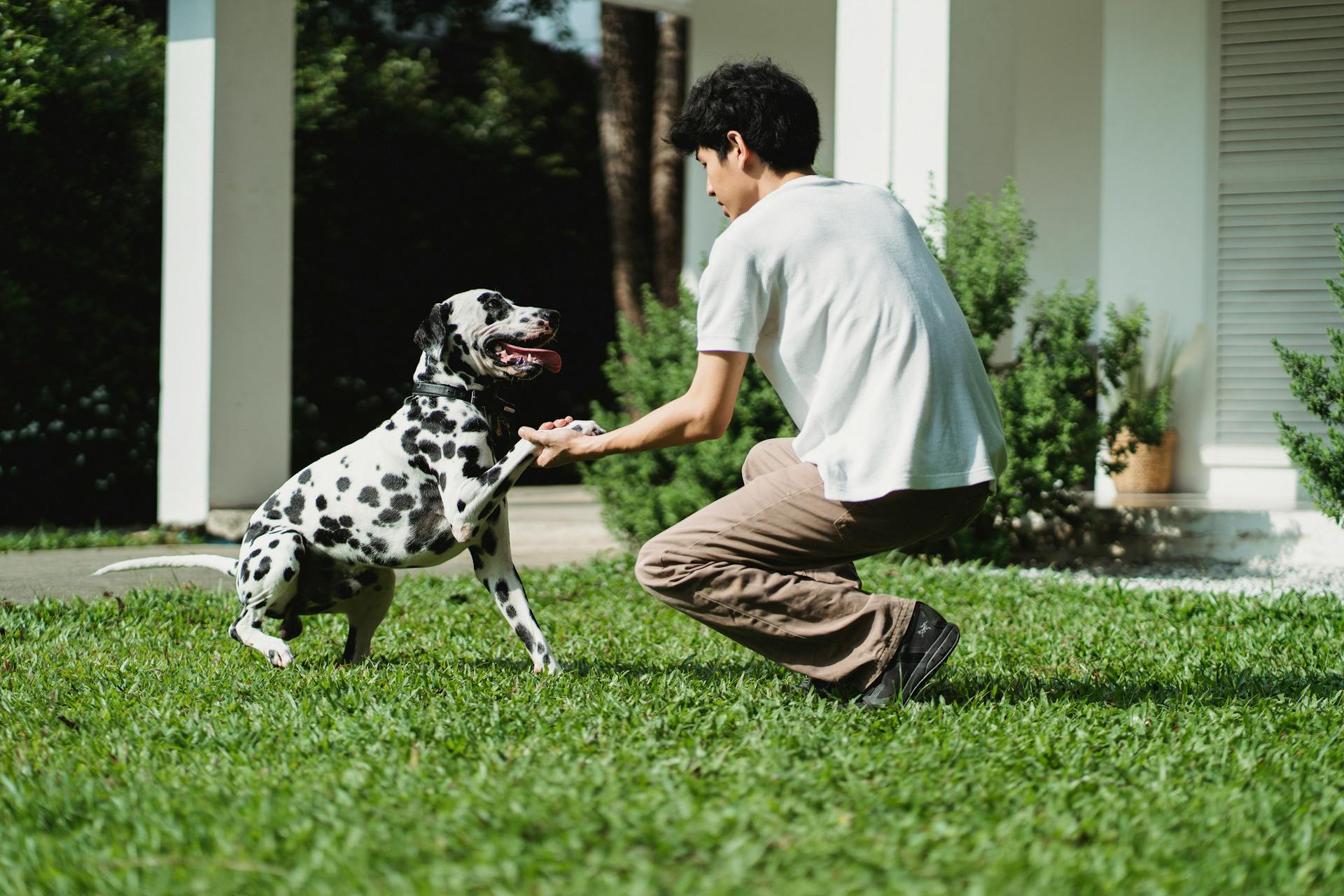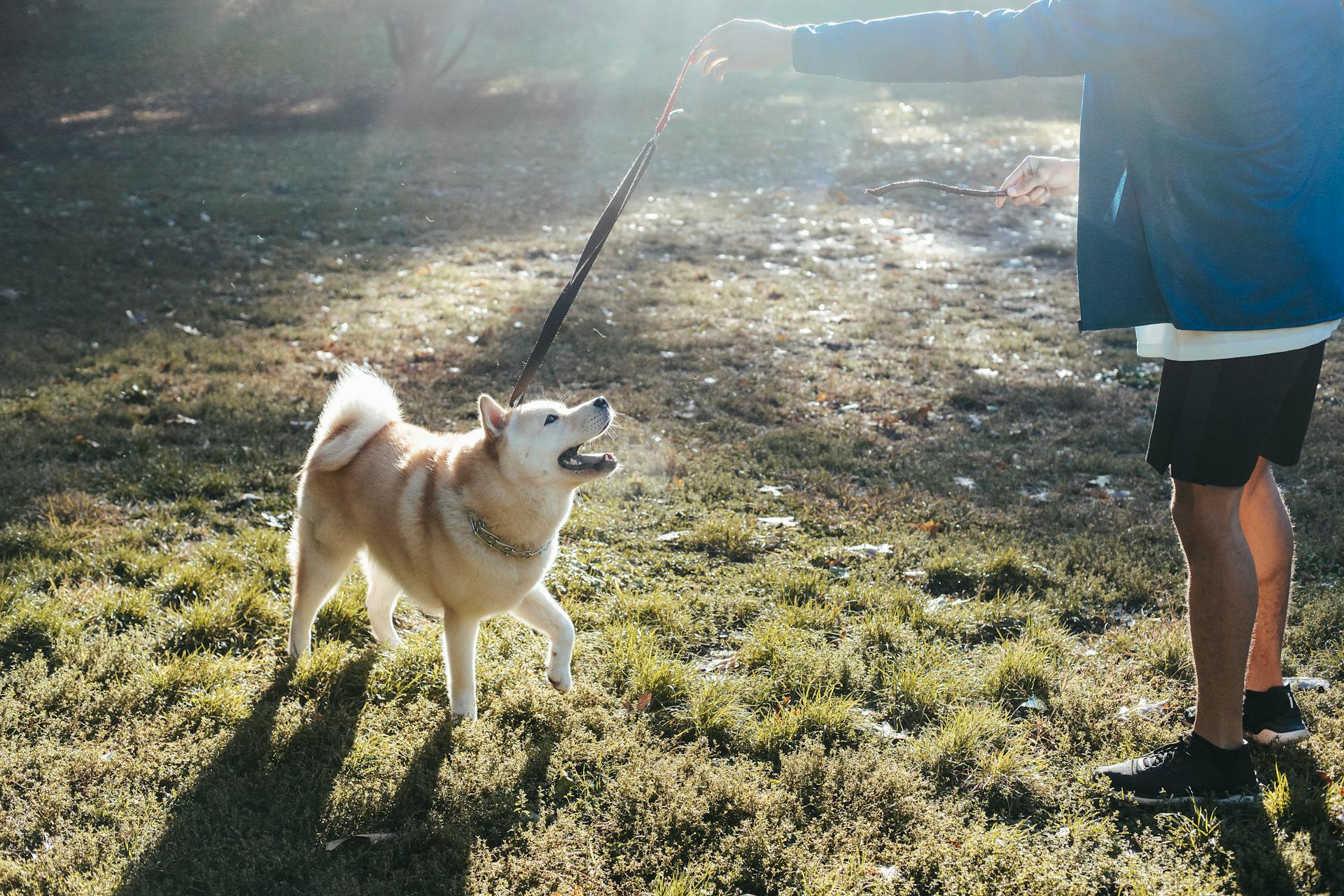
Classical conditioning is a type of learning where a dog associates a neutral stimulus with a naturally occurring stimulus that triggers a response. This concept was first introduced by Ivan Pavlov, a Russian physiologist who discovered that dogs would salivate at the sound of a bell if it was consistently paired with food.
In classical conditioning, the neutral stimulus becomes a trigger for the response, without any effort or intention from the dog. For example, if a dog consistently hears a can opener and then receives food, the sound of the can opener will eventually trigger salivation. This type of learning is automatic and doesn't require any conscious effort from the dog.
Classical conditioning is often used in dog training to create associations between specific stimuli and desired behaviors. By consistently pairing a stimulus with a reward, a dog can learn to associate the stimulus with the reward, leading to a desired response.
One key aspect of classical conditioning is the use of a neutral stimulus, which becomes a trigger for the response. This is in contrast to operant conditioning, which involves the use of consequences, such as rewards or punishments, to shape behavior.
Discover more: Conditioned Emotional Response Dog Training
Classical Conditioning
Classical conditioning is a powerful tool in dog training, and it's rooted in the experiments of Ivan Pavlov. He taught dogs to associate the sound of a bell with food, causing them to salivate at the sound alone.
This principle relies on associative learning, where an animal connects a stimulus with a particular outcome. In dog training, this means associating a clicker sound with a reward like food.
By pairing a neutral stimulus, like a clicker, with an unconditioned stimulus, like food, a dog learns to associate the sound with the reward. This is known as classical conditioning.
The process involves creating an association between a naturally existing stimulus and a previously neutral one. Sounds confusing, but it's actually quite simple. The sound of a bell, for example, becomes a conditioned stimulus that evokes a response, like salivating.
Classical conditioning is used in animal training by repeatedly pairing the sound of a clicker with the taste of food, eventually producing the same response as the taste of food. This is a great way to teach dogs new behaviors, like "sit" or "stay".
Take a look at this: Just Food for Dogs vs Farmer's Dog
Here's a breakdown of the classical conditioning process:
Training Methods
Training methods play a crucial role in operant vs classical conditioning dog training. Both methods involve associative learning, but they differ in their approach.
Classical conditioning involves forming an association with an already naturally occurring event, whereas operant conditioning focuses on using reinforcement or punishment to increase or decrease a behavior. This process involves associating a voluntary behavior with a consequence.
In operant conditioning, the type of reinforcer used can impact the response rate. A variable-ratio schedule, for example, can result in a high and steady rate of response.
Operant conditioning can be broken down into four quadrants: positive reinforcement, negative reinforcement, positive punishment, and negative punishment. Positive reinforcement involves adding something desirable to encourage a behavior, such as a treat or praise.
Here's a breakdown of the four quadrants of operant conditioning:
- Positive Reinforcement: Adding something desirable (like a treat or praise) to encourage a behavior.
- Negative Reinforcement: Removing something unpleasant to encourage behavior.
- Positive Punishment: Adding something unpleasant to discourage a behavior.
- Negative Punishment: Removing something desirable to discourage a behavior.
Dog trainers often prioritize positive reinforcement, as it fosters a positive learning environment and strengthens the bond between the pet and the owner. By using positive reinforcement, trainers can encourage desired behaviors without resorting to punishment or negative reinforcement.
If this caught your attention, see: E Collar Dog Trainers
Evaluating Performance
Operant conditioning is all about associating behaviors with consequences, and it's essential to evaluate performance to see what's working and what's not.
In operant conditioning, behaviors that are followed by a reward are more likely to be repeated, while behaviors that are followed by a punishment are less likely to be repeated. This is because rewards and punishments are powerful motivators that can either encourage or discourage certain behaviors.
To effectively evaluate performance in operant conditioning, it's crucial to track and record the frequency and consistency of desired behaviors.
Here's an interesting read: Operant Dog Training
Evaluating Performance
Evaluating performance is a crucial step in achieving success, and it involves setting clear goals and measuring progress.
To set effective goals, you need to define what success looks like, just like a business does when setting Key Performance Indicators (KPIs).
Measuring progress against these goals is essential, and regular check-ins can help you stay on track.
For example, a company might set a goal to increase sales by 10% within a year, and then track its progress each quarter.
Consider reading: Dog Training Goals

Regular evaluations also help identify areas where you need to improve, such as a team's communication skills.
Improving communication skills can be done through training and practice, just like a company might implement a new communication strategy to improve customer satisfaction.
By regularly evaluating your performance, you can make adjustments and stay on track to achieve your goals.
Suggestion: Dog Communication
Statistical Analysis
Data analysis will be a crucial part of evaluating performance. A Generalized Linear Mixed Model (GLMM) will be used to account for repeated measures and investigate the effects of multiple subject variables.
Subject ID will be included as the repeated measure, taking into account the unique characteristics of each participant. Age, sex, breed, and training experience will be included as covariates to control for their potential impact on the results.
The training method and training unit will be examined as factors, with two possible training methods (Mixed vs Reward) and two possible training units (PSP, RPara) being compared. This will help identify which combination of training method and unit is most effective.
Three response variables will be analyzed separately: the number of training sessions necessary to reach the learning criterion, the qualitative score obtained in the test, and the quantitative score obtained in the test.
Additional reading: Two Week Dog Training Camp Cost
Takeaways and Conclusion
As you learn about operant vs. classical conditioning dog training, it's essential to remember that both approaches have their own unique benefits and drawbacks. Classical conditioning and operant conditioning are both important learning concepts that originated in behavioral psychology.
Classical conditioning is often more effective for certain learning situations, such as phobias or habits. Operant conditioning, on the other hand, is better suited for teaching new behaviors or modifying existing ones.
Both classical and operant conditioning can be used in dog training, but operant conditioning is often more practical and efficient. By understanding the key differences between these two approaches, you can determine which one is best for your dog's specific needs.
Kendra Cherry's expertise in psychosocial rehabilitation and psychology education shines through in her explanation of these complex concepts.
Discover more: E Collar Conditioning
Sources
- https://www.verywellmind.com/classical-vs-operant-conditioning-2794861
- https://www.ncbi.nlm.nih.gov/pmc/articles/PMC7895348/
- https://www.gingrapp.com/blog/the-science-behind-dog-training-understanding-canine-learning
- https://connellsdogtraining.com/blog/operant-conditioning
- http://nldogwhisperer.com/supplemental-training-resou/blog/the-use-of-classical-and-opera.html
Featured Images: pexels.com


